Commercial Recessed Lighting Solutions and Best Practices for Office, Retail, and Hospitality Spaces
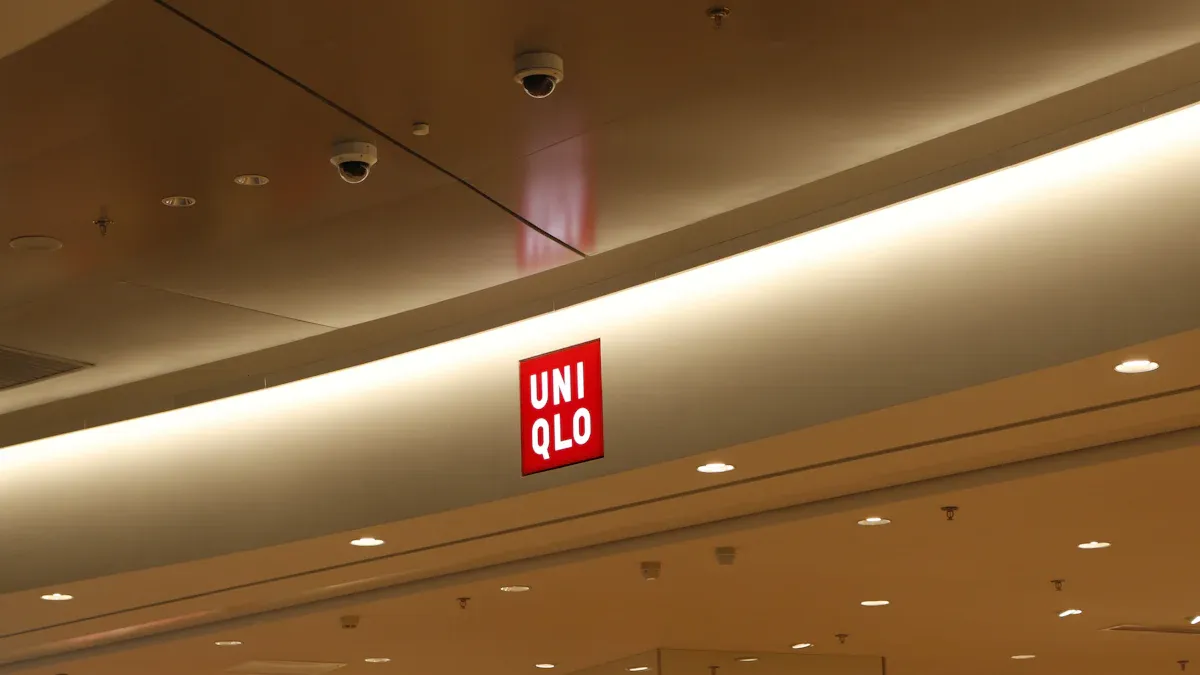
Commercial recessed lighting changes any business space. It makes the space look better and work better. Many businesses save up to 85% on energy with LED recessed lighting. This makes these lights cheap to use and long-lasting. The table below shows how commercial lighting, especially recessed lighting, is very popular. It also helps with saving energy:
Metric / Segment | Statistic / Value |
|---|---|
Energy savings of LED lighting | Up to 85% energy savings vs traditional |
LED commercial lighting market share | ~73% in 2024 |
Commercial office lighting market share | ~39% in 2024 |
Luminaires segment market share | ~76% in 2024 |
LED lighting CAGR | ~7% annual growth through 2029 |
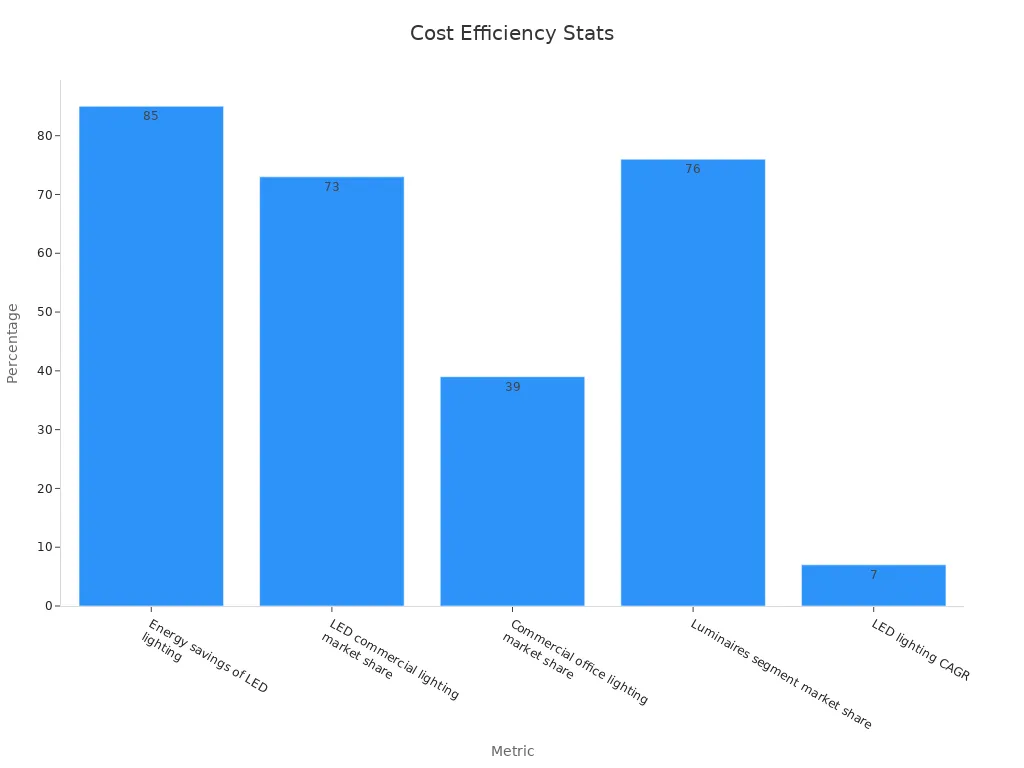
Picking the right commercial recessed lighting for offices, stores, or hotels helps people save money and time. Every guide about commercial lighting should help buyers look at Home, Product, and About Us pages. This helps them find the best Led Light for their business. This guide gives easy steps for picking and putting in recessed lighting for any business project.
Key Takeaways
LED recessed lighting uses less energy and lasts longer. This helps businesses save money and need less maintenance. Good lighting design makes people work better and feel happier. It can help stores sell more and make guests enjoy their visit. Putting lights in the right spots is important. Picking the best type and color temperature stops glare and shadows. This makes rooms safer and more comfortable. Smart controls like sensors and dimmers help save energy. They let people change the lights to what they want. Keeping lights clean and having experts install them is important. This makes sure lights work well, stay safe, and follow energy rules.
Key Considerations
Space and Function
When planning commercial lighting, you must know the space and what it is used for. Offices, stores, and hotels all need different lighting plans. Good lighting in offices can help people work better by 8%. Stores can sell up to 40% more when lights make products stand out and the space feels nice. Hotels do better with lights that can change, which can make guests give 20% better reviews. The table below shows how good lighting helps different places do better:
Industry Sector | Statistic Description | Impact on Performance or Outcome |
|---|---|---|
Workplace | Well-designed lighting leads to an 8% increase in productivity | Enhances employee comfort and performance |
Retail | Optimized lighting results in up to 40% increase in sales | Attracts more customers and improves product appeal |
Office | Natural and optimized artificial lighting boosts productivity by 15% | Improves work efficiency and output |
Hospitality | Adjustable lighting improves hotel guest reviews by 20% | Enhances guest satisfaction and ambiance |
Industrial Safety | Proper lighting reduces accidents by up to 60% | Significantly improves workplace safety |
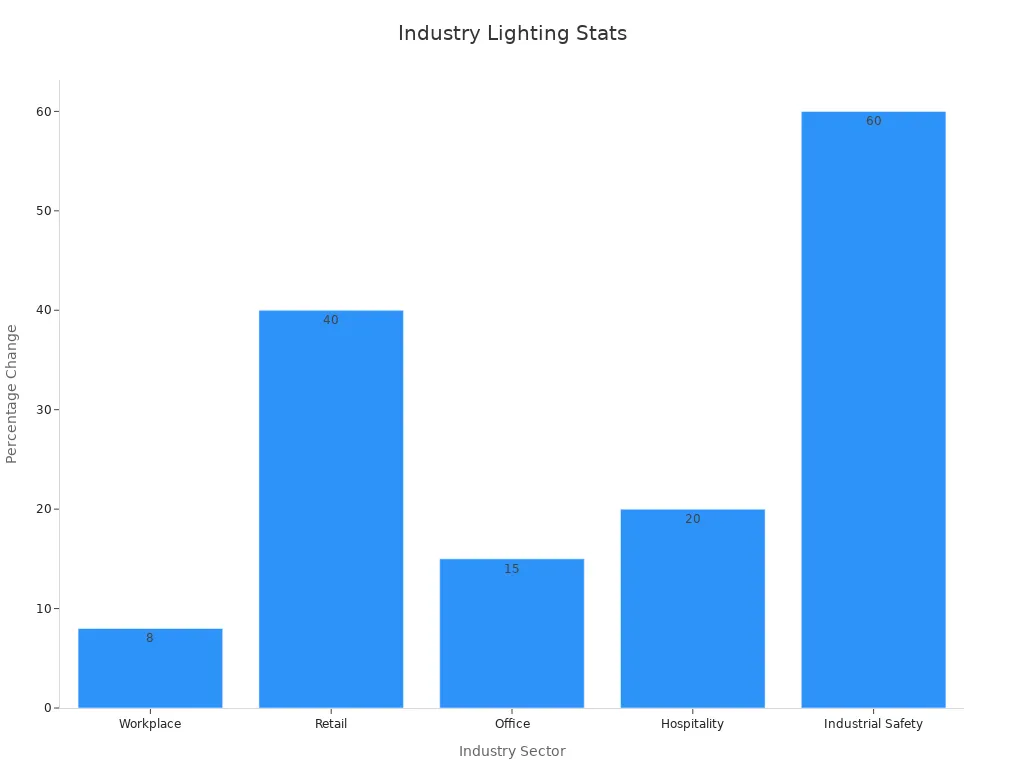
Putting recessed lighting in the right spots, about 4 to 6 feet apart, gives even light everywhere. This helps with both general and work lighting.
Ceiling Height
Ceiling height is very important for lighting in businesses. You need to measure it right, and pros often use laser tools to do this. If you get the height wrong, it can cost more money and cause problems with rules. BOMA surveys help show if there are any limits on ceiling height that could change your lighting plans. Some designers have had to wait longer and pay more because they did not measure ceilings right. If you plan well and use the right ceiling numbers, you can make a good lighting plan and follow the law.
Ambiance and Comfort
How lighting feels and how comfy it is can change how people feel in a space. Studies and real projects show these things:
Offices with layered, dimmable LEDs help workers feel better and focus more.
Warm lights in restaurants make people feel welcome and stay longer.
Schools with lights that can change help students and teachers pay attention.
Stores use special lighting to make products look good and bring in more shoppers.
Surveys say that being able to control lights makes people more comfortable and saves energy.
These facts show that using both general and work lighting helps people feel good and get things done.
Compliance and Safety
Following rules and keeping people safe is always important for business lighting. Building codes say recessed lighting must save energy and stop fires from spreading. For example, a building in California used JA8 dimmable LEDs to meet energy rules. Recessed luminaires also need to keep the ceiling safe from fire, following UL 263 and ASTM E119. Using certified lights and putting them in the right way keeps the building and people safe.
Energy Efficiency
Saving energy is a big reason to pick good lighting for businesses. Retrofit LED lights use up to 75% less energy than old bulbs and about half as much as fluorescent lights. LEDs can last up to 50,000 hours, so you do not have to change them often. Smart controls like motion sensors and dimmers help save even more energy. The table below shows the main benefits:
Feature | Data / Description |
|---|---|
Energy Reduction | LED retrofit lighting uses up to 75% less energy than incandescent bulbs. |
Comparison to Fluorescent | About 50% less energy consumption than fluorescent lighting. |
Lifespan | Retrofit LED systems last 25,000 to 50,000 hours, reducing replacement frequency. |
Maintenance Savings | Longer lifespan leads to lower operational and maintenance costs. |
ROI | Typical return on investment within 1 to 3 years due to energy and maintenance savings. |
Smart Controls | Motion sensors, dimmers, and time-based controls optimize energy use based on occupancy and time. |
Choosing energy-saving lighting for businesses saves money for a long time and helps the planet.
Commercial Recessed Lighting Types
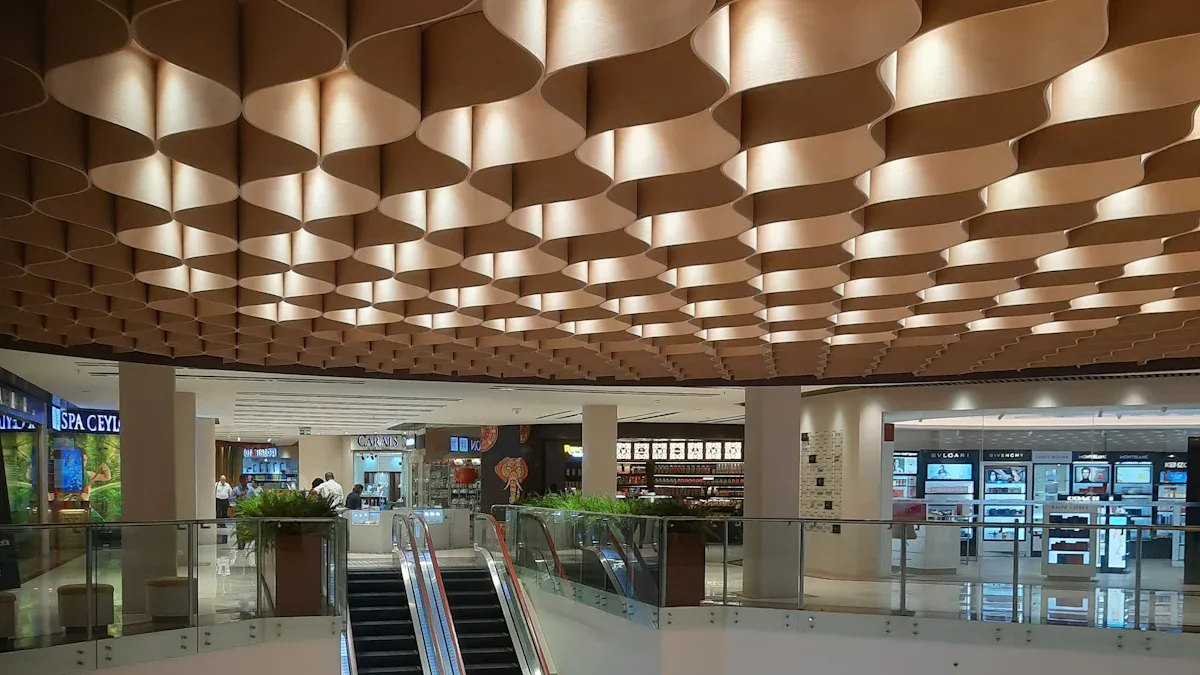
LED Recessed Lighting
LED recessed lighting is the best pick for businesses. These lights use led bulbs that save a lot of energy. They use up to 80% less power than old bulbs. A 10-watt led is as bright as a 60-watt regular bulb. Led downlights last from 15,000 to 50,000 hours. This means you do not need to change them often. You also spend less on fixing them. Good parts, like strong housings and drivers, make these lights great for busy places. LEDs come in many color temperatures and show colors well. This helps stores and hotels show products the right way. Smart tech lets people change how bright or warm the lights are. This saves even more energy and makes spaces feel better.
Commercial Downlights
Commercial downlights give strong light and can be used in many ways. They are very bright, with over 2,000 lumens. This makes them good for big rooms or high ceilings. New led tech, like COB and SMD, makes sure the light is bright and colors look the same. You can pick from different beam angles, from narrow to wide. This helps meet many lighting needs. These downlights also cut down on glare. Many models meet UGR under 19 to help your eyes. You can dim them and use controls like 1–10V, DALI, or wireless systems. This helps make lighting fit people’s needs. Safety is important too. Some have fire ratings and IP44 or IP65 protection. This makes them safe for offices, stores, and hotels.
Recessed Downlights
Recessed downlights and commercial downlights are not the same. They are used in different places and work in different ways. The table below shows how they are different:
Application Area | Recessed Downlights (Residential) | Commercial Downlights (Commercial) |
|---|---|---|
Living Room | Ambient, dimmable, comfort-focused | Not typical |
Office | Not typical | Uniform, anti-glare, high-output lighting |
Retail | Not typical | Adjustable, high-CRI, low-glare for displays |
Hospitality | Decorative, mood lighting | Dimmable, color-tunable for lobbies, restaurants |
Healthcare | Not typical | IP65, anti-glare, high-CRI for clinics |
Home downlights focus on comfort and style. Commercial downlights are made to work well, last long, and follow safety rules.
Trim and Finish Options
Trim and finish choices help stop glare and make lights look nice. Baffle trims make light softer and cut glare. These are good for offices and hotels. Reflector trims make lights brighter and send light where it is needed. This is helpful in stores. Matte finishes lower glare and match the ceiling. Trimless profiles with diffusers give smooth, even light and look modern. Picking the right trim helps lights look good and work well.
Beam Spread and Placement
Beam spread tells how light covers a space. Medium beams are good for work areas. Wide beams are best for lighting up a whole room. Where you put downlights matters for even light. A good rule is to space lights half as far as the ceiling is high. For a 10-foot ceiling, put lights about 5 feet apart. This gives even light with no dark spots or glare. Recessed troffers are also good for big open spaces to give even light.
Tip: Always plan where to put lights before you start. This helps you get the best lighting in business spaces.
Solutions by Space
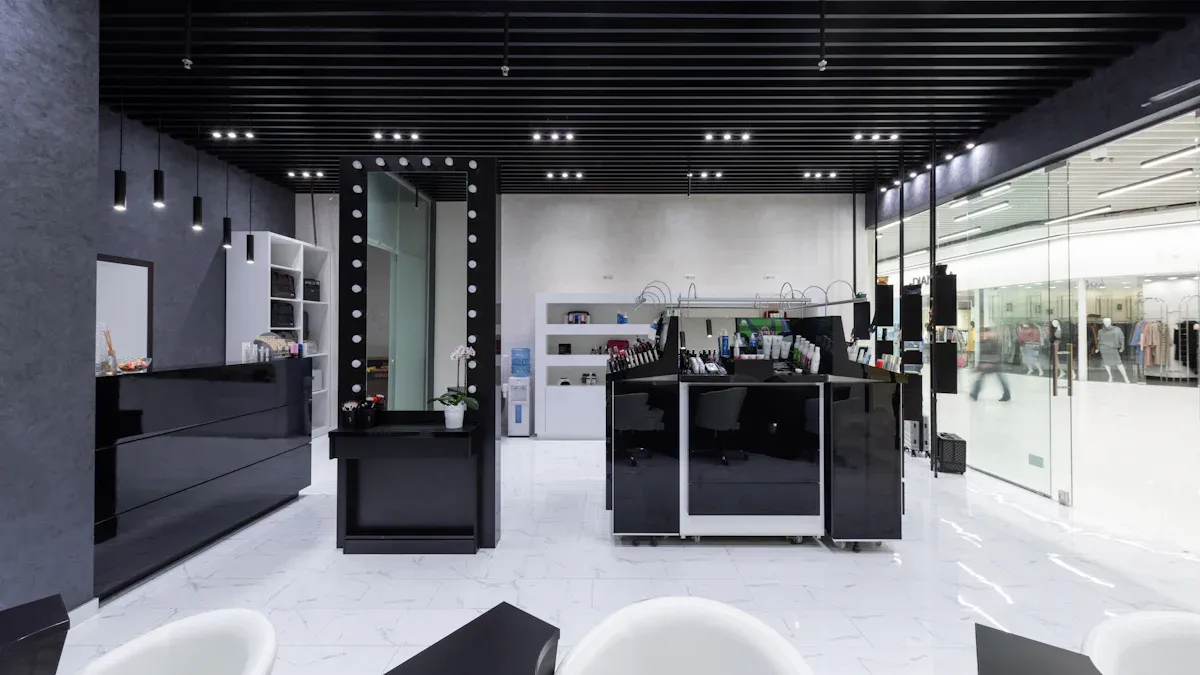
Office Lighting
Lighting in offices needs to be planned carefully. Bright, even light helps people work better and feel comfortable. If the light is too bright in some spots, it can hurt your eyes. This can make you tired and make it hard to focus. Glare can even make it hard to see and do your work. Studies show that less flicker and letting workers change their own lights makes them happier. This also helps them want to do a good job. These things help people get more work done.
One study found that sunlight and the right amount of light help people see better and stay awake. It also makes them like their office more. Using shades can stop glare and help people think better. Good lighting, the right color, and letting people control their lights make offices nicer. OSHA says to put lights in the right place and use covers to stop glare. Lights should go the same way people look. Using covers on lights helps too. Lights for certain jobs help people pay attention and not get distracted.
Commercial downlights help meet these rules. They give even, soft light at desks. The IESNA says offices need 30-50 foot-candles of light. Conference rooms need up to 70 foot-candles. The table below shows what is needed for different office areas:
Area | Minimum Foot-Candles | Recommended Foot-Candles | Color Temperature (K) | CRI |
|---|---|---|---|---|
Offices | 30 | 30-50 | 4000-5000 | 80+ |
Conference Rooms | 20 | 20-70 | 4000-5000 | 80+ |
Reception/Breakroom | 10 | 10-30 | 3000-4000 | 80+ |
Good lighting uses both general and work lights. Recessed downlights spread light all over the room. Desk lamps or lights under shelves help with close-up work. Putting lights in the right spot stops shadows and glare. This keeps eyes comfortable. Dimmable downlights let people change how bright the room is. In conference rooms, more light and a neutral color help people take notes and see well. Warmer lights in breakrooms make the space feel friendly.
Tip: Pick commercial downlights with electronic ballasts. This helps stop flicker and makes offices more comfortable.
Retail Lighting
Stores need different kinds of lights to look good and sell more. Using layers of light helps bring in shoppers and show off products. Studies say that mixing general, accent, and work lights makes people stay longer and buy more. General lighting sets the mood for the whole store. Accent lights point out special items. Work lights help at checkouts and fitting rooms.
Accent lights make certain displays stand out. Work lights at the register help workers do their jobs well. For example, Ikea uses work lights at checkouts to stop mistakes. Walmart in Japan sold more by using accent lights near the checkout. Changing the color or brightness of lights can make products look better and make shopping fun.
Stores also need to think about color temperature. Experts say 4000K to 5000K is best for seeing things clearly. Here are some tips for store lighting:
4000K lights look like daylight and help people see products.
5000K LEDs are very bright and make products pop.
High CRI (90 or more) shows colors the right way.
3000K is warm and cozy but not as good for seeing details.
Stores often use commercial downlights that can change where the light shines. Long, thin LED lights fit into modern stores and light up aisles or walls. This helps stores move things around and keep the space looking good.
Hospitality Lighting
Lighting in hotels and restaurants changes how people feel and keeps them safe. Big hotel brands use special lighting to make guests feel welcome and remember their stay. Some hotels use lights that help people relax and feel good. Lighting is important for making guests happy and comfortable.
Hotels use cool LED ceilings and fun lights in bars to make guests feel good. General and accent lights help set the mood and make spaces look deep. Dim lights make restaurants feel cozy. Brighter lights are better for casual places. Custom lights help hotels show off their brand and make spaces work for different needs.
Good lighting also helps people feel safe by making sure everything is bright and easy to see. Warm lights make guests want to stay longer and enjoy themselves. Accent lights show off important spots and help people pay attention. These ideas work in all kinds of restaurants and hotels to make people feel good and safe.
Hotels often use recessed downlights with wall lights or hanging lights. Using different kinds of lights adds layers and makes spaces interesting. Long, thin LED lights look modern and light up halls, lobbies, or dining rooms. Dimmable downlights let workers change the light for different times or events.
Note: Good hospitality lighting should make people feel good, keep them safe, and match the brand for a great visit.
Commercial Lighting Design Best Practices
Planning and Layout
Good commercial lighting starts with a clear plan. You need to think about where to put each light. Experts say to use different types of lighting together. This means using ambient, task, and accent lighting. Ambient lighting lights up the whole room. Task lighting helps people see better when working. Accent lighting makes displays or special features stand out. Each area gets the right amount of light for what people do there.
Putting lights in the right spots stops glare and dark corners. Designers look at how tall the walls are and how big the room is. They also think about what each space is used for. If walls are low, you might need wall lights or hanging lights. Dimmers and controls let people change how bright the lights are. This makes the space more flexible. Rules like the National Electrical Code and Energy Star help keep things safe and save energy.
Tip: Make a detailed lighting plan before you start. This helps you avoid mistakes and follow all the rules.
A site survey is the first step in any lighting project. Designers measure the room and check the lights already there. They look at windows and how much sunlight comes in. They also check the building’s wiring. Designers talk to clients about what they want. They find out if there are any problems or limits. The plan covers what lights to use, where to put them, and how to control them. It also includes emergency lights and when to check or fix things. Following these steps helps businesses get good lighting that makes people comfortable and helps them work.
Professional Installation
Having a pro install the lights is very important. Licensed workers know how to follow all the rules. They have special certificates like CLCATT and Lighting Control Installation Certificates. These show they know how to test and install lighting controls the right way.
Certification Type | Purpose | Description |
|---|---|---|
CLCATT Certification | Shows pro testing of lighting controls | Needed for Title 24 and other rules |
Lighting Control Installation Certificate | Shows lights meet energy rules | Proves lighting controls are set up right |
Acceptance Testing Certification | Checks if lighting controls work well | Tests automatic controls and shut-off systems |
Pros help stop electrical problems and damage to the building. They pick the best lights and where to put them. Their experience helps match the lighting to what the client wants and can pay for. Working with certified pros means the job is safe and follows the rules.
Key benefits of professional installation:
Lighting plans made for each space
Safe wiring and correct light placement
Less chance of electrical problems
Work with other building teams
Stay on schedule and budget
Maintenance
Keeping lights working well means checking them often. Regular checks find problems like flickering or broken lights. Cleaning lights and changing old parts helps them last longer. A good plan includes regular checks, quick repairs, and updates as new tech comes out.
Facility managers should write down when they fix or check lights. This helps stop surprise problems and helps with warranties. Using good lights and LED downlights means you do not have to replace them as much. LEDs last longer and need less care than old bulbs. This makes them a smart pick for businesses.
Note: Taking care of lights saves money by using less energy and stopping work delays.
Smart Controls
Smart controls make business lighting better and save energy. These include sensors that turn lights on or off when people enter or leave. Daylight dimmers change the light when the sun is bright. Networked controls let you change lights from one place. These systems help lower bills and give more control.
Tax breaks and rebates help pay for smart lighting. For example, Section 179D gives up to $1.13 per square foot for energy-saving lights. Utility rebates can give up to $249 for each LED light. There are extra rewards for using smart controls. These programs help businesses save money and use better lighting.
Real stories show smart controls work. A store in Sweden saved 40% on energy with smart systems. A tall building in New York City used smart sensors and saved 30% each year. Offices with sensor switches and dimmers used up to 23% less energy. These examples show smart controls really save money and help the planet.
Callout: Smart controls help save energy and make spaces nicer for workers and customers.
A good lighting guide always talks about smart controls. These systems help businesses stay ahead, follow rules, and save money for years.
Trends and Innovations
Human-Centric Lighting
Human-centric lighting is changing how people feel at work. Studies show this lighting can help people work better by up to 15%. Office workers with these lights have less eye strain and fewer headaches. They also focus better. These lights change color and brightness during the day. This matches the sun’s natural light. It helps keep your body’s clock in balance. People sleep better and feel more awake. One office used tunable LED lights and workers were happier. They also made fewer mistakes. Hospitals with circadian-friendly lighting help patients get better faster. Staff are also happier. New technology like AI and IoT lets people have their own lighting settings. This helps people feel good and saves energy.
Building Integration
Modern buildings use smart lighting that connects to other systems. These lights use sensors to know when people are in the room. They also change when there is sunlight. Facility managers can control all the lights from one place. This saves energy and keeps rooms comfortable. Smart lighting works with heating, cooling, and security systems. This makes the building work better. Many businesses now use LED lights with smart controls. This helps save energy and lets people change the space easily. Building integration also makes it easy to fix or update lights.
Tip: Using smart building systems helps companies save money and make spaces nicer for everyone.
Sustainability
Sustainability is very important for business lighting. Studies show LED lamps use less energy and are better for the planet than old lights. A life-cycle study looks at things like global warming, fossil fuels, and toxicity. LEDs do better in almost every way. Making LEDs uses some resources, but they last a long time and use little energy. This makes them the best choice. New tech like PeLEDs can help the planet even more. The table below shows how LEDs compare to other lights:
Lighting Type | Energy Use | Environmental Impact | Lifespan |
|---|---|---|---|
Incandescent | High | High | 1,000 hours |
CFL | Medium | Medium | 8,000 hours |
LED | Low | Low | 25,000+ hours |
Picking LED recessed lighting helps businesses go green and save money over time.
Commercial recessed lighting helps offices, stores, and hotels save energy. It also makes spaces more comfortable and work better. A guide helps teams figure out what they need and pick the best lights. It also helps them plan how to put in the lights. The guide talks about checking and fixing lights often to keep them working well. Use the guide to look for ENERGY STAR LEDs, sensors that know when people are there, and ways to use sunlight. Facility managers should use the guide to take out extra lamps and follow IES rules. For the best results, ask lighting experts for help and read the guide often to learn about new ideas and money-saving deals.
Let in sunlight and turn off lights when not needed
Use special lights for work desks or tables
Change old lights to ENERGY STAR LEDs
Put in sensors to save energy
Check and fix lights on a schedule
A guide helps every lighting job meet energy, safety, and money goals.
FAQ
What are the main benefits of commercial recessed lighting?
Commercial recessed lighting helps save energy and lasts a long time. These lights do not need much fixing. They make rooms look neat and give even light everywhere. Many businesses pick LED recessed lights to save money and make spaces more comfortable.
How often should businesses maintain recessed lighting?
Facility managers should check recessed lighting two times each year. Cleaning the covers and changing broken parts keeps lights working well. Doing this often stops lights from going out and keeps everyone safe.
Can recessed lighting work with smart controls?
Yes. Most new recessed lighting works with smart controls. Facility managers can use sensors, dimmers, and timers to change the lights. Smart controls help save energy and make workers and guests feel better.
What color temperature works best for offices, retail, and hospitality?
Offices use 4000K to 5000K to help people focus. Retail stores pick 3500K to 5000K to make products stand out. Hospitality spaces like 2700K to 3500K for a warm and friendly feeling.
Is commercial recessed lighting suitable for all ceiling heights?
Manufacturers make recessed lighting for different ceiling heights. High-output downlights are good for tall ceilings. Shallow fixtures work well in low ceilings and still give good light.
See Also
Effective Lighting Strategies And Applications For Commercial Spaces
Enhancing Recessed Ceilings With Optimal Lighting Techniques
Guide To Recessed Lighting Types Installation And Design
Innovative Lighting Approaches For Retail Store Environments
Advanced Lighting Innovations For Contemporary Business Interiors

